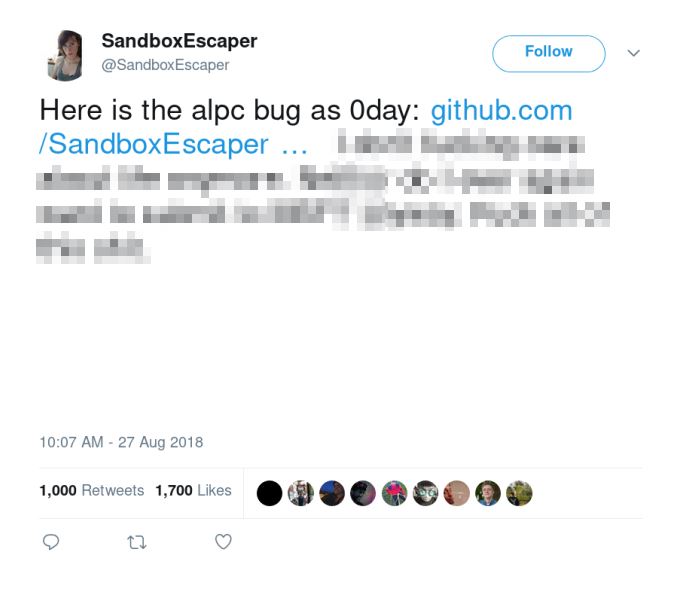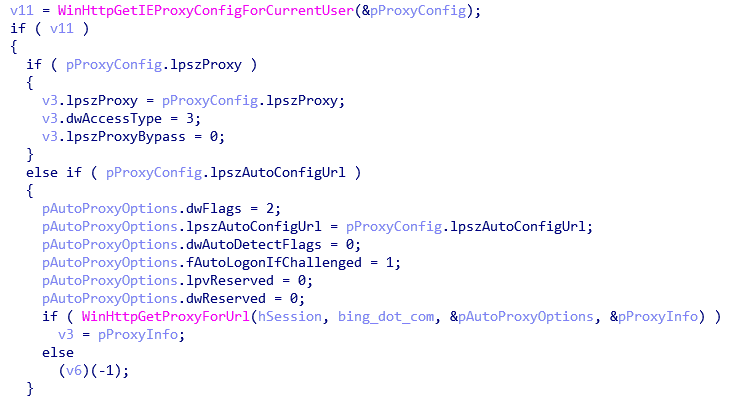Update (11 September 2018): Microsoft has provided a patch for this in today’s Windows Update.
On August 27, 2018, a so-called zero-day vulnerability affecting Microsoft Windows was published on GitHub and publicized via a rather acerbic tweet.
It seems obvious that this was not part of a coordinated vulnerability disclosure and there was no patch at the time this tweet (since deleted) was published to fix the vulnerability.
It affects Microsoft Windows OSes from Windows 7 to Windows 10, and in particular the Advanced Local Procedure Call (ALPC) function, and allows a Local Privilege Escalation (LPE). LPE allows an executable or process to escalate privileges. In that specific case, it allows an executable launched by a restricted user to gain administrative rights.
The tweet linked to a GitHub repository that contains Proof-of-Concept code for the exploit. Not only was a compiled version released – the source code was also. Consequently, anyone can modify and recompile the exploit, in order to "improve it", evade detection, or even incorporate it into their code.
As one could have predicted, it took only two days before we first identified the use of this exploit in a malicious campaign from a group we have dubbed PowerPool. This group has a small number of victims and according to both our telemetry and uploads to VirusTotal (we only considered manual uploads from the web interface), the targeted countries include Chile, Germany, India, the Philippines, Poland, Russia, the United Kingdom, the United States and Ukraine.
PowerPool arsenal
This newly isolated group already has quite a range of tools at its disposal. We will provide brief analyses of some of them here.
ALPC Local Privilege Escalation exploit
The PowerPool developers did not reuse the binary that was provided by the vulnerability’s discloser. They modified the source code slightly and recompiled it.
The exploit has been documented by its original author and has been covered by security researchers and CERTs.
The flaw is in the SchRpcSetSecurity API function, which does not check the user’s permissions correctly. Thus, a user can have write permissions on any file in C:\Windows\Task regardless of its actual permissions. That allows a user with only read permissions to replace the content of a write-protected file.
As any user is able to write in C:\Windows\Task, it is possible to create a file in this folder that is a hard link to any target file. Then, by calling the broken function SchRpcSetSecurity, it is possible to gain write access to that target file. To create a Local Privilege Escalation, the attacker needs to choose the target file that will be overwritten. This needs to be done carefully: it needs to be a file that is executed automatically with administrative rights. For example, it can be a system file, or the updater of previously installed software that is regularly executed by a task. The final step is to replace the content of this protected target file with malicious code. Thus, at the next automatic execution, the malware will have administrative rights regardless of its original rights.
PowerPool’s developers chose to change the content of the file C:\Program Files (x86)\Google\Update\GoogleUpdate.exe. This is the legitimate updater for Google applications and is regularly run under administrative privileges by a Microsoft Windows task.
The sequence of operations shown in the figure above allows the PowerPool operators to gain write access to the executable GoogleUpdate.exe. Then, they overwrite it with a copy of their second-stage malware, described below, in order to gain SYSTEM privileges the next time the updater is called.
Initial compromise
The PowerPool group uses different approaches to initially compromise a victim. One is to send emails with their first-stage malware as an attachment. It may be too early to say, but to date we've seen very few occurrences in our telemetry, so we assume that the recipients are carefully chosen rather than PowerPool running a massive spam campaign.
On the other hand, we know that their spams have been spotted in the past. According to a SANS blogpost released in May 2018, they used a trick with Symbolic Link (.slk) files to distribute their malware. Microsoft Excel can load these files that update a cell and force Excel to execute PowerShell code. These .slk files seem to be distributed in spam messages too. Pivoting from the first file mentioned in the SANS blogpost (SHA-1: b2dc703d3af1d015f4d53b6dbbeb624f5ade5553), on VirusTotal, it is possible to find the related spam sample (SHA-1: e0882e234cba94b5cf3df2c05949e2e228bedd2b):
Windows backdoors
The PowerPool group mainly uses two different backdoors: a first-stage backdoor used just after the first compromise and then a second-stage backdoor, probably on the most interesting machines.
First-stage backdoor
This is basic malware used for reconnaissance on the machine. It comprises two Windows executables.
The first of these is the main backdoor. It establishes persistence through a service. It also creates a mutex named MyDemonMutex%d where %d ranges from 0 to 10. It is able to collect proxy information and the address of the C&C server is hardcoded into this binary. It can execute commands and performs some basic reconnaissance of the machine, which is then exfiltrated to the C&C server.
The second of these executables has a single purpose. It takes a screenshot of the victim’s display and writes it in MyScreen.jpg. This file can then be exfiltrated by the main backdoor.
Second-stage backdoor
This malware is downloaded via the first stage, presumably when the operators believe the machine is interesting enough for them to stay on it for a longer time. However, it is clearly not a state-of-the-art APT backdoor.
Again, the C&C server address is hardcoded in the binary, and has no mechanism to update this crucial configuration item. This backdoor seeks commands from http://[C&C domain]/cmdpool and downloads additional files from http://[C&C domain]/upload. These additional files are mainly the lateral-movement tools mentioned below.
The supported commands are:
- Execute a command
- Kill a process
- Upload a file
- Download a file
- List a folder
They are sent in JSON format. The examples below are instructions to execute a command and to list a folder:
Lateral movement tools
Once the PowerPool operators have persistent access to a machine with the second-stage backdoor, they use several open-source tools, mostly written in PowerShell, to move laterally on the network.
- PowerDump: This is a Metasploit module that can retrieve usernames and hashes from the Security Account Manager (SAM).
- PowerSploit: This is a post-exploitation framework in PowerShell, à la Metasploit.
- SMBExec: A PowerShell tool to perform pass-the-hash SMB connections.
- Quarks PwDump: A Windows executable that can retrieve Windows credentials.
- FireMaster: A Windows executable that can retrieve stored passwords from Outlook, web browsers, etc.
Conclusion
The disclosure of vulnerabilities outside of a coordinated disclosure process generally puts many users at risk. In this case, even the most up-to-date version of Windows could be compromised as no patch was released when the vulnerability and exploit were published. The CERT-CC provides some mitigations but Microsoft has not officially approved them.
This specific campaign targets a limited number of users, but don’t be fooled by that: it shows that cybercriminals also follow the news and work on employing exploits as soon as they are publicly available.
ESET Researchers will continue tracking any malicious usage of this new vulnerability. Indicators of Compromise can also be found on GitHub. For any inquiries, or to make sample submissions related to the subject, contact us at threatintel@eset.com.
Update (11 September 2018): Microsoft has provided a patch for this in today's Windows Update.
Indicators of compromise
Hashes
| SHA-1 | Type | Detection name |
|---|---|---|
| 038f75dcf1e5277565c68d57fa1f4f7b3005f3f3 | First stage backdoor | Win32/Agent.SZS |
| 247b542af23ad9c63697428c7b77348681aadc9a | First stage backdoor | Win32/Agent.TCH |
| 0423672fe9201c325e33f296595fb70dcd81bcd9 | Second stage backdoor | Win32/Agent.TIA |
| b4ec4837d07ff64e34947296e73732171d1c1586 | Second stage backdoor | Win32/Agent.TIA |
| 9dc173d4d4f74765b5fc1e1c9a2d188d5387beea | ALPC LPE exploit | Win64/Exploit.Agent.H |
| Detection names |
|---|
| Win32/Agent.SZS |
| Win32/Agent.TCH |
| Win32/Agent.TEL |
| Win32/Agent.THT |
| Win32/Agent.TDK |
| Win32/Agent.TIA |
| Win32/Agent.TID |
| C&C servers |
|---|
| newsrental[.]net |
| rosbusiness[.]eu |
| afishaonline[.]eu |
| sports-collectors[.]com |
| 27.102.106[.]149 |












